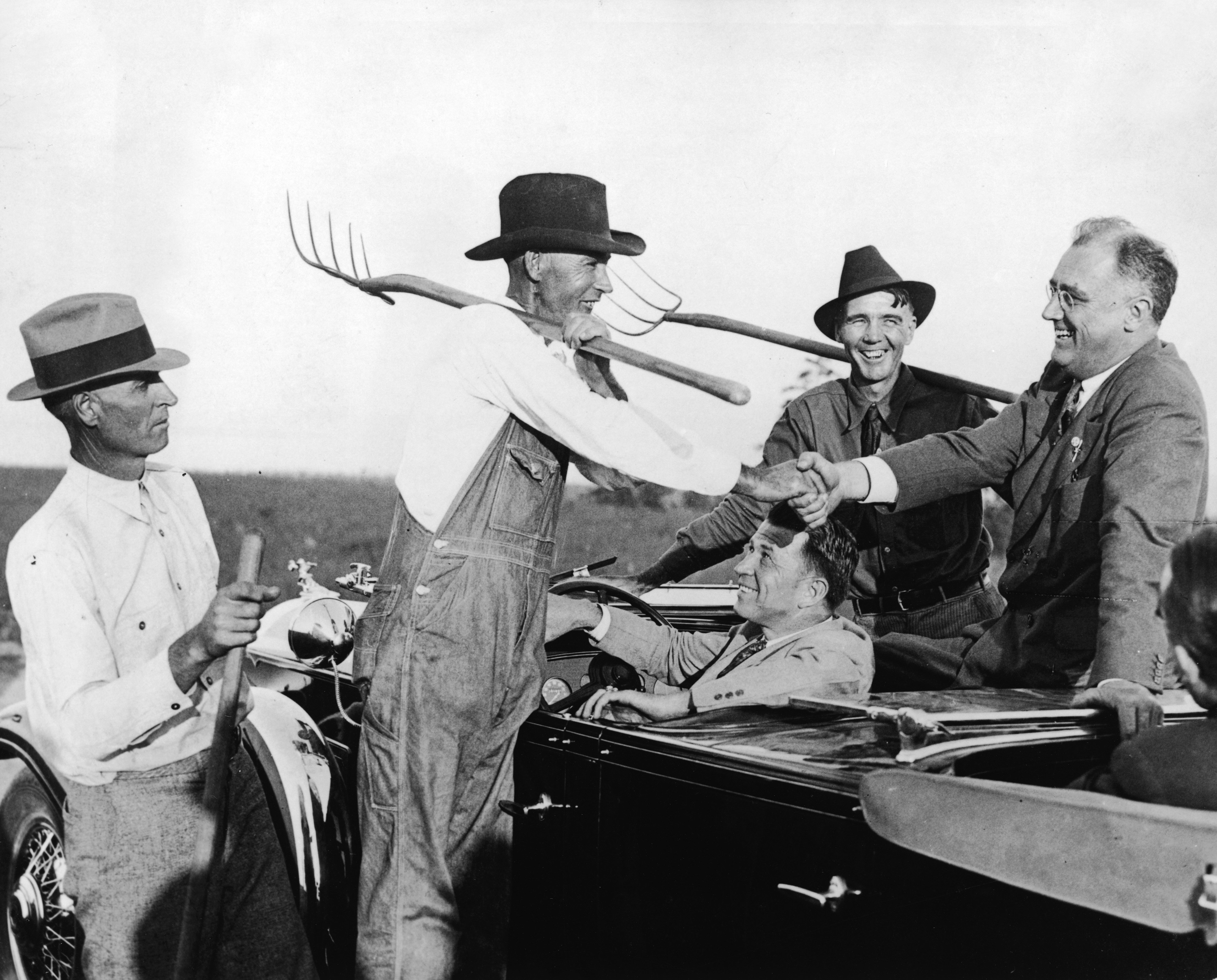In his first duel with Wendell Willkie, FDR campaigned against giant holding companies that soaked small electricity customers
Midway into his first term, President Franklin Roosevelt went to war with the American electric utility empires. The November 1934 elections had increased already large Democratic majorities in Congress, positioning Roosevelt to fulfill one of his campaign promises. In his January 4, 1935, State of the Union address, he urged abolition of “the evil of holding companies,” referring to the multi-layered, closely held financial structures that since the 1920s had dominated the power trade, raking in huge, opaquely accounted-for profits (See sidebar, “Pyramids of Power,” below).
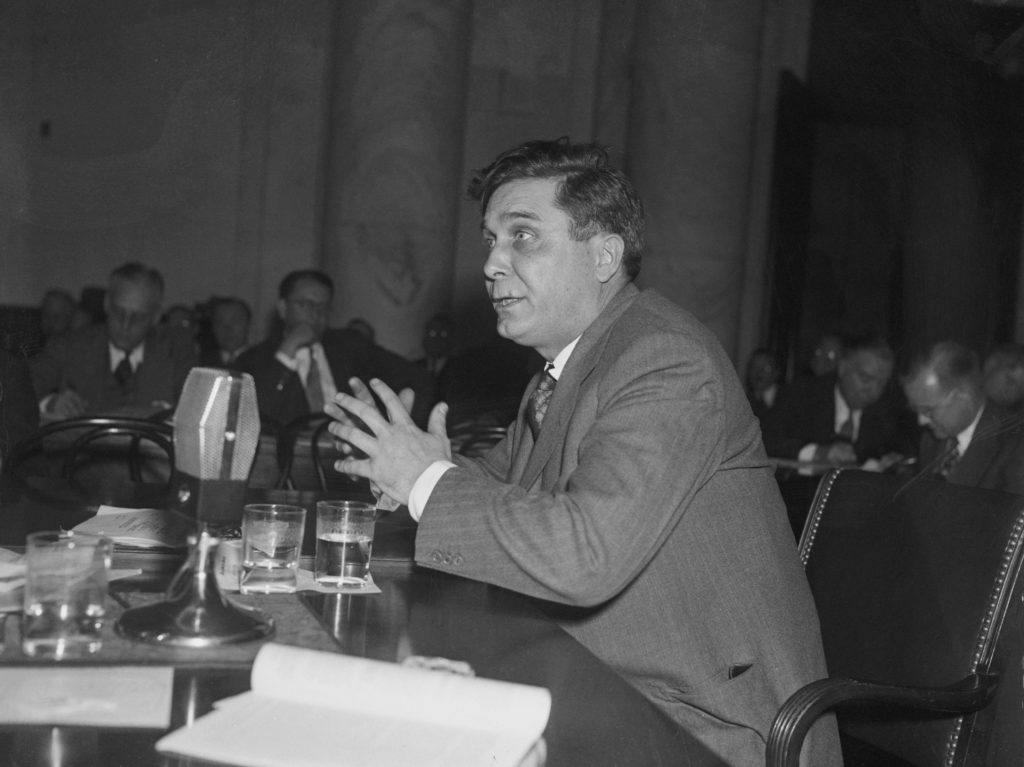
In addressing the Depression during 1933-34, FDR had focused on jobs programs like the Tennessee Valley Authority, created to construct dams and promote development in one of the country’s poorest regions. At the head of the opposition to this expanded government role in the marketplace stood the charismatic Wendell Willkie, president of Commonwealth & Southern, the area’s major holding company. The Roosevelt/Willkie confrontation set off what historian Thomas McCraw called “one of the most intense struggles between government and business in American history.” Now, with the TVA fight and other ongoing New Deal battles as a backdrop, the president wanted to reform the entire power industry, further pitting him against Willkie.
Roosevelt had laid out his vision for an electrified America in the 1932 campaign. Speaking in Portland, Oregon, in an appearance that was carried on nationwide radio, he attacked holding companies and called for a massive federal program of dam-building and rural electrification. “The question of power,” FDR declared, “is primarily a national problem.” He lambasted utilities for an “unprincipled campaign of misinformation” that had flooded newspapers and airwaves with self-serving claims and even circulated school lesson plans extolling utilities and justifying higher rates.
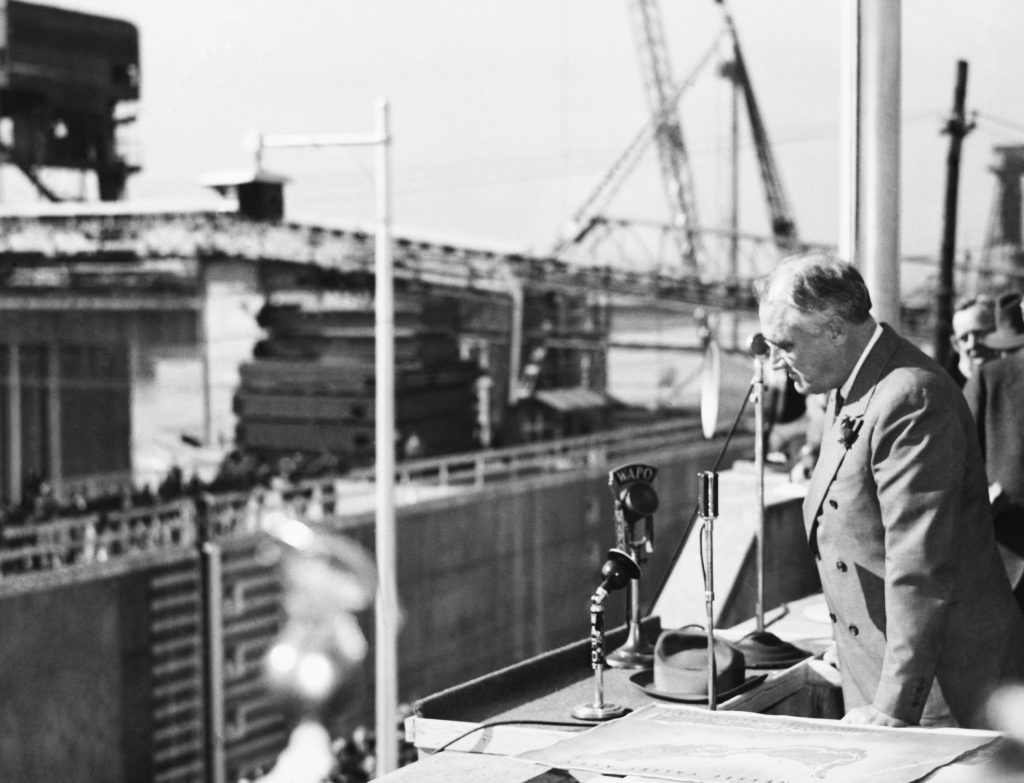
Critics portrayed Roosevelt as a revolutionary, but at heart he was a reformer. Expecting to be blasted for advocating socialism, he insisted, “The development of utilities should remain, with certain exceptions, a function for private initiative and private capital.” FDR did not believe, however, that state governments could effectively regulate holding companies. After the 1934 elections widened his edge in Congress, he asked his staff to draft legislation that would destroy these corporate behemoths and the threat they posed to ratepayers, although not the operating utilities they controlled. He met with utility leaders, including Willkie, who diplomatically told reporters he was “very favorably impressed with President Roosevelt’s attitude on the power question.” The utility magnate was more candid in a telegram to his wife: “CHARM EXAGGERATED STOP I DIDN’T TELL HIM WHAT YOU THINK OF HIM.”
In January 1935, Willkie and two fellow holding company chiefs met with FDR, Federal Power Commission officials Frank McNinch and Basil Manly, and TVA Director David Lilienthal. As Roosevelt was enumerating holding company abuses, Lilienthal later wrote in his journal, Willkie “was getting hotter and hotter.” Finally, Lilienthal noted, the normally affable CEO leaned in and, gesturing forcefully at the president with his spectacles, told Roosevelt, “‘If you will give us a federal incorporation law, we can get rid of holding companies.’ He didn’t preface it by ‘Mr. President,’ and he didn’t say it with the courtesy that you would accord if you were addressing the vice president of a bank, much less the President of the United States.”
Roosevelt was sympathetic to enacting an incorporation law, under which corporations operating interstate would have to obtain federal charters. However, according to Lilienthal, Willkie’s rudeness shocked his fellow utility executives “as if Willkie had suddenly produced a gun and started shooting.” The discussion degenerated, with the president bristling as Willkie continued to “bark and point his glasses. Finally Willkie said, ‘Do I understand then that any further efforts to avoid the breaking up of utility holding companies are futile?’ The President gave him one look and said simply, ‘It is futile,’” Lilienthal concluded.
Some in Congress wanted to nationalize utilities—a route Roosevelt did not want to take. Eager to send a bill to Congress, he summoned his advisers on January 21 to decide whether to regulate holding companies’ structures or to tax them to death by going after their intercorporate dividends. Following an animated discussion the president embraced the regulatory approach.
FDR insisted, though, on eliminating multistate holding companies. Under his proposal, holding companies would have to register with the Securities and Exchange Commission, which during a period of adjustment would work with holding companies to flatten them by eliminating layers and geographically limit their reach. That restructuring would be voluntary. But after January 1, 1938, the SEC would have authority to eliminate any holding company that controlled more than one geographically integrated system. This provision became known as the “death sentence,” a label for which Willkie claimed credit. The death sentence option became the target of all-out industry resistance.
On February 6, 1935, Senator Burton Wheeler (D-Montana) and Representative Sam Rayburn (D-Texas), chairs of the congressional commerce committees, introduced the Public Utilities Holding Company Act. The bill included both the registration requirement and the death sentence. Press reaction was mixed. Some papers suggested that FDR was proposing to kill off holding companies when all they needed was proper regulation. New York Times correspondent Arthur Krock, however, wrote that the bill represented “essential politics” for Roosevelt as well as “personal conviction.”
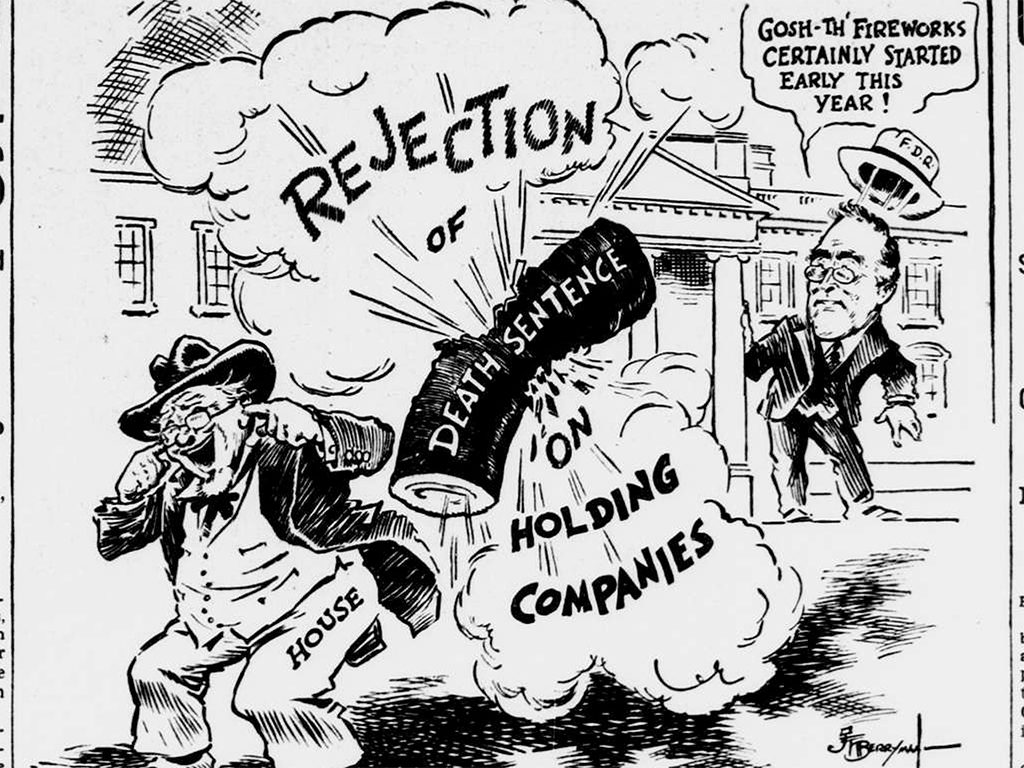
The ensuing five-week lobbying campaign, according to Roosevelt biographer Kenneth S. Davis, “raised such a hue and cry as had not been raised against a single measure, perhaps, since Stephen Douglas’s Kansas-Nebraska bill.” Utilities urged shareholders to write their congressmen. “Quick death for the holding companies by execution is proposed,” Georgia Power, a subsidiary of Willkie’s Commonwealth & Southern, reported in its company newsletter. “And slow death for the operating companies.”
The bill’s supporters went into similarly high gear. Alluding to the difficulty of regulating utilities controlled by out-of-state companies, humorist Will Rogers joked in his newspaper column, “A Holding Company is a thing where you hand an accomplice the goods while the policeman searches you.” An outpouring of criticism followed. “Well I dident [sic] figure that little half witted remark would upset the whole holding company business,” Rogers wrote a few days later. “But I forgot that a remark generally hurts in proportion to its truth.”
Rayburn scheduled House hearings for the week after he introduced the bill, with Willkie as industry’s leadoff witness. The Indiana-born Wall Street executive with the down-home Hoosier manner paced up and down, alternately blustering and whispering as he defended holding companies, attributing their lapses to a few bad actors. Yet Willkie voiced support for all the bill’s provisions except the death sentence. Some colleagues strongly disagreed with this concession, but Willkie’s persuasive, reasonable demeanor and his rhetorical skill enhanced his position as the industry’s national leader. Wit and a deft touch with the press also helped. Departing New York to testify in Washington, Willkie said that he was going to the capital “to see that my contempt for the New Deal remains founded on familiarity.”
In private committee talks, Rayburn came to see that he lacked the votes for the death sentence. On May 14, Wheeler’s Senate committee reported out a version of the bill with the death sentence intact, but Democrats in the full Senate were divided. After two weeks of heated debate, Senator William Dieterich (D-Illinois) announced he would offer an amendment to strike the death sentence. Wheeler rushed to the White House to urge Roosevelt to oppose Dieterich’s amendment publicly. The president was having breakfast in bed. Scrawling a note affirming his opposition to the amendment, he handed it to Wheeler. “You can show this to the boys,” FDR said.
That afternoon, when Dieterich claimed on the Senate floor to have Roosevelt’s support for his amendment, Wheeler read the president’s note aloud. The amendment to kill the death sentence lost by one vote. But the utility lobby’s strength was on display; 28 Democrats, including 20 New Deal stalwarts, had voted to delete the death sentence—the first serious break in Roosevelt’s bloc. The Holding Company Act passed with a comfortable Senate majority, 56 to 32.
The House Commerce Committee remained split; on June 22, Rayburn reported the bill out without the death sentence. A preliminary House count indicated FDR was 40 votes shy of a majority that would restore the fatal sanction. The perpetually optimistic Roosevelt thought he could hold most Democrats provided they had to vote on the record, setting up loyalists to be rewarded and dissidents to be punished. But Rules Committee Chairman John J. O’Connor (D-New York) would allow only a “teller” vote, so called because in that process two members of Congress tallied the votes of colleagues walking past, with no record kept of individual positions. On July 1, House tellers tallied only 146 votes for restoring the death sentence and 246 votes against, the first major House defeat of Roosevelt’s presidency. On July 2, the weakened bill passed 323 to 81.
With the August recess a little more than a month away, Roosevelt continued to hope the House-Senate conference committee would report out a bill incorporating the death sentence. Rayburn, who expected the conferees to eliminate the provision, told the president the utility sector had the “richest and most ruthless lobby Congress has ever known.” Roosevelt instructed Vice President John Nance Garner to appoint supportive Senate conferees and to tell them to hold strong.
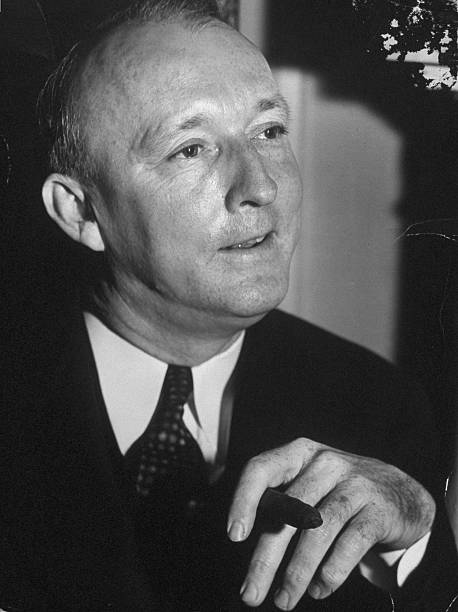
By July pressure for and against the bill was so intense that both houses began investigating lobbying excesses. Little came of the House inquiry. In the Senate, though, a panel chaired by New Dealer Hugo Black of Alabama was especially vigorous. Black, who had denounced holding companies as “a blood-sucking business,” believed exposure of utility lobbying practices would undercut industry’s credibility.
Black’s special investigative committee started its hearings Friday, July 12. “Tell the boys of the press to come in!” he shouted. “The show is about to begin.” The first witness was Philip H. Gadsden, chairman of the Committee of Public Utility Executives, a lobbying group. Only that morning, Senate investigators had surprised Gadsden in his office and rushed him to Capitol Hill. The unprepared executive disclosed that industry’s Edison Electric Institute had established and guided his committee in response to the Wheeler-Rayburn bill, instructing him to take no minutes and to hide the connection between the two bodies. Those revelations fueled further investigation.
While waiting for information from holding companies, Black heard from Representative Dennis Driscoll (D-Pennsylvania), who had received over 800 telegrams opposing the bill. All the messages had come from Warren, a small town in his district. Nearly three senders’ names in four started with early letters of the alphabet, suggesting they had come from a phone book or a list of utility customers. Many supposed senders denied authorship. Black’s staff found that the local office of Associated Gas & Electric, a 10-layer holding company pyramid, had had a salesman generate the telegrams. AG&E also had paid messengers three cents for each signature the boys obtained. As a witness Black called Elmer Danielson, 19, asking if petitioners had known what they were signing. To much laughter, the unsophisticated youth said he had explained the complicated Wheeler-Rayburn bill. “Another revelation like that, and we will compel the House to approve the death sentence,” Black told a friend.
But Black needed a higher-profile villain than a messenger boy. He had been trying since July 14 to subpoena AG&E founder and president Howard C. Hopson. In a farcical two-week game of cat and mouse, Hopson evaded committee investigators, changing hotels in Washington and driving around Virginia and West Virginia. Eventually he agreed to appear before the friendlier House committee. As Hopson was leaving the House hearing, a Senate process server appeared. Hopson’s security staff muscled the man aside. After another chase, which a reporter compared to “Eliza crossing the ice, hotly pursued by bloodhounds,” and another subpoena—the utility executive ignored it—a unanimous Senate issued a warrant for Hopson’s arrest on charges of contempt of Congress.
Hopson’s testimony proved worth the effort that obtaining it had required. Making use of the executive’s tax return, which Roosevelt ordered released to the dismay of civil libertarians, Black harvested a wealth of evidence. Hopson’s company had diverted to him money owed shareholders as dividends. Prodigious revenues wrung from ratepayers had gone for lobbying, phony telegrams had inundated Congress, and AG&E had destroyed records. Hopson became the poster boy for holding company sins. But even these revelations could not break the conference committee logjam. With that strong House vote against the death sentence reinforcing House conferees’ resolve and the Black hearings and administration pressure fortifying their Senate counterparts, debate intensified.
As the House-Senate conference ran into mid-August, Roosevelt adopted a plan suggested by Harvard Law School professor and frequent advisor Felix Frankfurter. The president asked the chairman of the House Ways and Means Committee to bottle up a highly popular tax bill in committee as a means of keeping Congress in session until conferees came to terms on the Holding Company Act. FDR said the House bill was unacceptable but hinted at compromise by acknowledging that no particular legislative wording was necessary.
Roosevelt also proposed a specific compromise: eliminate the death sentence, but stipulate that a holding company could control more than one system if that was the only way the additional system could survive economically. The second system could not be so large or so dispersed as to prevent efficient management and regulation, and no more than two holding company levels would be allowed above an operating utility. These conditions would spell the breakup of Willkie’s and many other large holding companies.
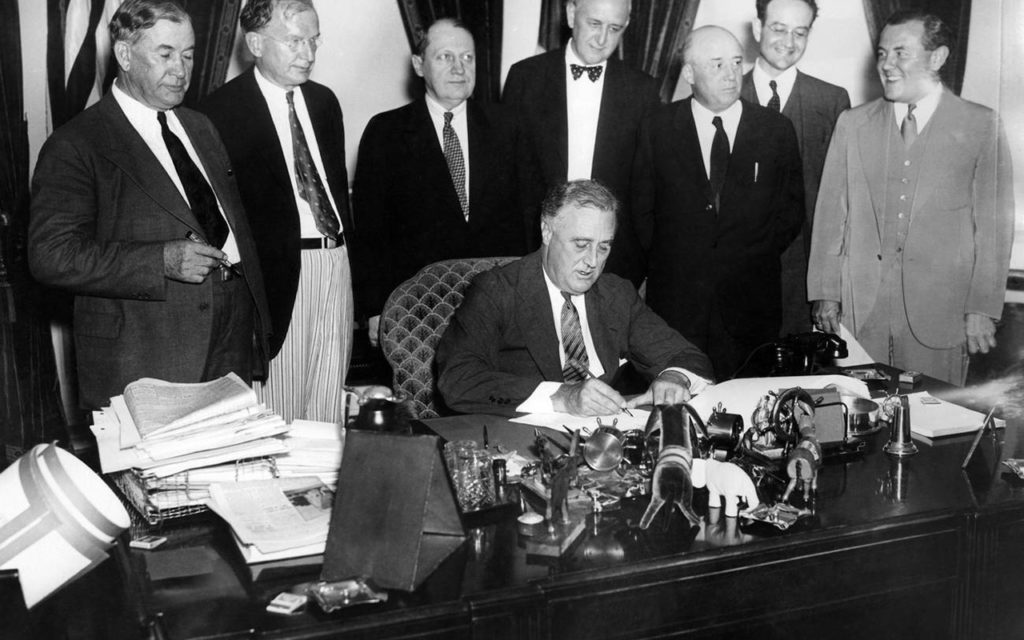
A full-court press by Democratic leaders persuaded the conference committee to accept that arrangement, and the previously disapproving House passed the revised bill 219 to 142. Signing the measure, Roosevelt said that if Congress “had done nothing more than pass this bill, the session would be regarded as historic for all time.” Willkie was undeterred. “While a straitjacket will keep a man out of trouble,” he complained, “it is not a suitable garment in which to work.” He hoped that the closely divided Congress might make possible a reconsideration in 1936.
The utilities went to court, petitioning a friendly U.S. district court judge to declare the law and its de facto death sentence unconstitutional. SEC Chairman James Landis called those proceedings a “sham,” but a favorable ruling in November triggered suits by many holding companies seeking to void the requirement that they register with the SEC by that December 1. Willkie went further, announcing that Commonwealth & Southern not only would not register but also, joined by 18 other utilities, would file another suit to challenge the law’s constitutionality.
The government fought back, quickly filing a complaint against Electric Bond and Share, one of the largest holding companies. The federal suit highlighted the new law’s registration provision, which the SEC thought more easily defensible than the implicit death sentence. Federal lawyers petitioned to delay the case, hoping one or more conservative U.S. Supreme Court justices would retire—as did occur. In 1937 Justice Willis Van Devanter gave up his seat, filled by Senator Hugo Black. Justice George Sutherland retired in 1938, replaced by Solicitor General Stanley Reed.
In March 1938, the Court ruled on Electric Bond and Share v. SEC. Reed recused himself because as solicitor general he had signed briefs in the case. Justice Black participated, although The New York Times noted that as a senator he had “attacked holding companies as ‘rattlesnakes’ and urged their destruction.” Declining to rule on the law’s constitutionality, the justices voted 6-1 to uphold mandatory registration.
Though the Holding Company Act’s constitutionality was still up in the air, the Electric Bond and Share ruling allowed the SEC to impose mandatory registration. Within hours of the decision Willkie announced that Commonwealth & Southern would comply. In March 1940 the SEC notified the company that it was in violation of the law. Willkie wrote shareholders, “We expect to do all in our power…to prevent the forced sale of our properties.” However, others would have to carry that torch. Willkie’s fervent opposition to Roosevelt’s power policies had gained him Republicans’ admiration and catapulted him to national prominence, and after winning the Republican nomination for president in June 1940 he resigned from the utility to campaign.
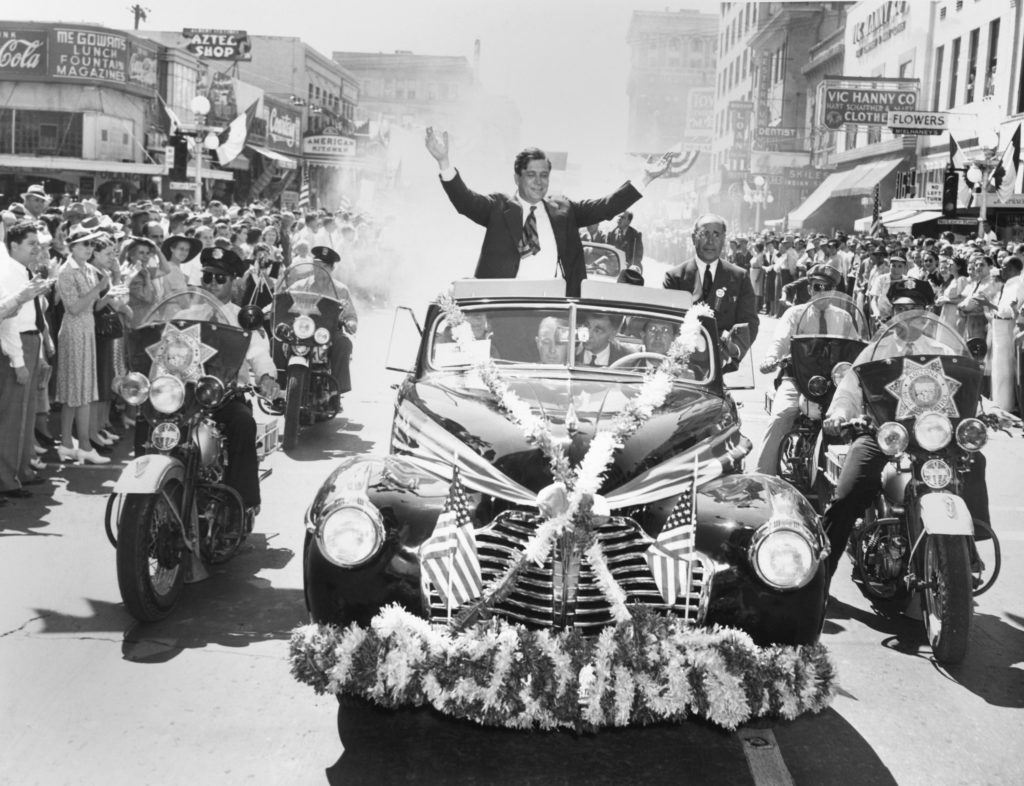
By 1941, with the war in Europe creating steep demands on the power sector as American manufacturers increased production, a number of holding companies sought to delay SEC action so they could ramp up production without fear of enforcement. SEC chairman Edward C. Eicher stood firm. “The present scattered systems have ‘Balkanized’ the utility assets of this country,” Eicher said. “The resultant hodgepodge utility operations require the surgery of [the death sentence] in order that integrated utility properties may be developed in accordance with the power needs of the area served.” As it happened, new government dams in the Tennessee and Columbia river valleys wound up meeting much of the nation’s increased wartime power demand.
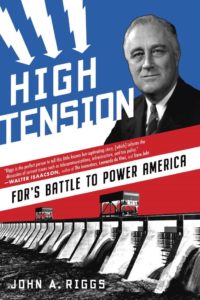
By John A. Riggs
Diversion Books, 2020, $18.99
In 1946 the Supreme Court ruled the Holding Company Act constitutional. Multistate companies had to seek the best deal they could from the SEC. Most did not survive. Between 1938 and 1950, non-contiguous or multi-layered companies had to dispose of 759 subsidiaries. As of 1958, only 18 registered interstate companies remained. “No company died that seemed to have the slightest excuse for living,” economic historian Harold Underwood Faulkner concluded.
Willkie’s effective defense had forced a compromise, but Roosevelt supporters pointed to electricity rates as evidence of his policies’ success. From 1920 to 1932, when holding companies claimed to be providing efficiencies through management and system integration, inflation-adjusted residential electric service fees were flat. From 1933 to 1942, with government pressure on holding companies and competition from federally produced power, rates fell about 40 percent in real terms. And, per Roosevelt’s 1932 campaign promise, the utility industry remained largely private.
_____
[hr]
Pyramids of Power
Holding companies, which largely were responsible for America’s electrification, were elaborate structures that utilities and investment banks created in the 1910s and 1920s to provide capital to a rapidly growing industry starved for funds. By the end of the 1920s, nine holding companies held control of utilities producing 75 percent of the nation’s power. A few owners controlled these holding companies and all the utilities under them with a relatively small investment in the voting stock of the holding company at the top of each pyramid. Critics complained that the operating utilities controlled by holding companies overcharged, and those operating across state lines were impossible for individual states to regulate. Rather than allowing subsidiary utilities to reinvest profits, holding companies often siphoned revenues up the pyramids as dividends paid to the ultimate owners. According to the Federal Trade Commission, in 1924 rates of return to these owners on their investments ranged from 19 to 55 percent. Some engaged in insider trading and inflated their holdings’ value with various financial shenanigans. During the 1920s, whether motivated by greed, zeal for growth, or both, many utilities and holding companies borrowed recklessly to expand. As long as share prices rose, they could cover their debts. After the Crash of 1929, though, multiple utility holding companies went under. Many middle-class investors, expecting safety and rapid growth, had bought utility stocks or bonds and lost their life savings. —John A. Riggs
This story will appear in the February 2021 issue of American History. It was adapted from High Tension: FDR’s Battle to Power America by John A. Riggs with permission from Diversion Books.

